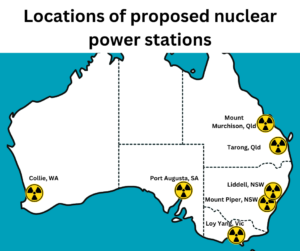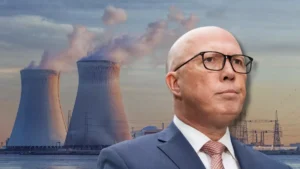Earlier this year the federal Coalition began spruiking their ill-conceived idea to build nuclear reactors on the land of retired coal-fired power plants as a solution to Australia’s energy future. That talk has now reached fever pitch as Peter Dutton announced his proposed sites last week – including in the Latrobe Valley.
Leaving aside for a moment the prohibitive costs and safety concerns associated with nuclear reactors – it seems clear that Peter Dutton nor his Coalition colleagues bothered doing their homework or actually speaking to local people on the ground before naming the Latrobe Valley as a potential site.
If he had conducted even a superficial survey of community attitudes to the proposition of turning the Latrobe Valley into a nuclear power hub, he would have realised quickly that the vast majority of the community can see this proposition for what it is – a dangerous distraction that ignores the more urgent need for safe mine rehabilitation.
As it currently stands, the so-called retired coal mine sites being referred to are facing ongoing issues associated with rehabilitating the existing toxic and unstable mine pits that remain full of flammable coal. It doesn’t take too much of a mental stretch to realise that mixing old unstable mine pits and nuclear reactors is not likely to end well.
The Latrobe Valley also sits in an earthquake hotspot near the fault lines of the Strzelecki Ranges. The Fukushima nuclear disaster, which led to mass evacuations, hundreds of billions of dollars of economic loss and the release of large amounts of radioactive contamination to the air and ocean, clearly showed the danger of building a nuclear reactor on a fault line.

The other glaring gap in the nuclear push is water. According to the World Nuclear Institute, one nuclear reactor requires between 1514 and 2725 litres of water per megawatt hour. That equates to billions of gallons of water per year, all of which requires intensive filtering.

Pictures by Shutterstock, Sitthixay Ditthavong
As recently as 2019 local MP Darren Chester already publicly stated that the government had no plans to change the moratorium in place on nuclear power – let alone that his own electorate would be the site on which it would be staged.
Mr Chester has previously said safety concerns would need to be ameliorated and the development would need to demonstrate direct “social and economic benefits”. So it sounds like having opposed the nuclear push it now seems he is prepared to support his Coalition’s nuclear pipedream, at the right price.
As the area that has powered Victoria for decades, people in the Latrobe Valley know better than anyone that we are now in the midst of a clean energy transition. We can’t afford to wait decades for nuclear reactors when we have clean sun and wind energy right here and right now, already powering 40 per cent of our electricity grid.
It is also disingenuous that after decades of inaction and outright climate denial from the Coalition parties, the same party are now spruiking nuclear as the fastest way to reduce emissions. Instead, the Coalition needs to get with the program and focus on the fast and fair rollout of renewable energy as we phase out burning coal and methane gas.
As some Coalition MPs have let slip, talk of nuclear reactors is really code language for extending the life of coal and gas for at least 20 years until nuclear reactors can be regulated, built and actually generate energy into the Australian energy grid. This is incompatible with our global commitment to limit warming to 1.5 degrees and will see Australians more vulnerable to extreme heat, fires and floods.
While many local people are experiencing a worsening cost-of-living crisis, the federal Coalition is proposing we transition Australia to the most expensive source of energy in the world. The current levelised cost of energy (LCOE) puts nuclear generated electricity at $US180 per megawatt hour compared to $US50 for onshore wind and $US60 for utility-scale solar.
In addition to the very high cost of electricity from nuclear reactors is the huge cost to build them. In the UK, the Hinkley Point C reactor was originally budgeted to cost £18 billion, it will now cost up to £46 billion with inflation factored in. This is in a country with an established regulatory framework and nuclear industry.
Despite the reassurances of those in the Coalition who really should know better, there is still no long-term solution for the radioactive waste from nuclear reactors that meets community expectations for safety and environmental protection. Australia currently struggles to store low-grade waste from nuclear medical facilities, let alone the more radioactive waste from nuclear power reactors.
Dating right back to when the British first tested nuclear weapons in central Australia in the 1950s and ’60s in South Australia, First Nations communities, particularly in remote areas, have borne the brunt of the harm caused by nuclear activities in Australia.
First Nations communities continue to protest and take legal action against radioactive waste burial on country. There are communities who are still unable to access their land due to radioactive waste – let’s not add to that shameful legacy. Not here, not anywhere.
In pitching this radioactive, future technology, the Coalition is ignoring the fact that the clean energy transition is already well under way – and the Latrobe Valley community is out in front with a vision for a healthy, sustainable and safe future in our region. Gippsland has more than 25 large renewable energy projects in the pipeline, worth $54 billion.
With the support of the local community, these projects are already delivering the kinds of jobs and energy solutions we need now, not two decades away.
This article was first published in the Canberra Times on July 11 2024. You can read it here>>